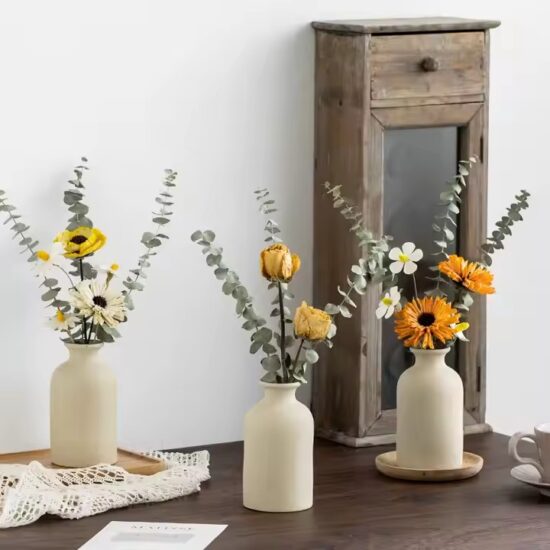bob@nbdho.com
Comparison of Common Materials Used in Ceramic Vases: Which One is Right for You?
Comparison of Common Materials Used in Ceramic Vases
Introduction
Ceramic vases come in a variety of materials, each offering unique characteristics in terms of durability, appearance, and suitability for different uses. Understanding the differences between these materials can help you select the right vase that meets your aesthetic and functional needs. This article compares the most common materials used in ceramic vase production: porcelain, earthenware, stoneware, and terracotta.
1. Porcelain
Porcelain is a high-quality ceramic material known for its strength, translucency, and smooth texture. It is fired at very high temperatures (around 1200–1400°C), resulting in a dense, non-porous surface. Porcelain vases often feature a glossy finish and are prized for their elegant appearance.
Advantages:
-
High durability and chip resistance
-
Fine, smooth texture with a glossy finish
-
Excellent for detailed and delicate designs
Disadvantages:
-
Typically more expensive
-
Can be more fragile compared to stoneware in some applications
2. Earthenware
Earthenware is fired at lower temperatures (about 1000–1150°C), resulting in a more porous and less durable material. It often has a rustic, earthy look and is usually glazed to improve waterproofing and durability.
Advantages:
-
Affordable and easy to shape
-
Rustic aesthetic suitable for casual décor
-
Ideal for decorative rather than functional use
Disadvantages:
-
More porous and prone to chipping
-
Requires glazing for waterproofing
3. Stoneware
Stoneware is fired at high temperatures (around 1200–1300°C), making it denser and stronger than earthenware. It is typically more durable and resistant to chips and cracks, with a slightly coarse texture. Stoneware vases can be glazed or left unglazed depending on design preferences.
Advantages:
-
Durable and chip-resistant
-
Versatile glazing options
-
Suitable for both decorative and functional use
Disadvantages:
-
Heavier than porcelain and earthenware
-
Texture may be less refined than porcelain
4. Terracotta
Terracotta is a type of earthenware made from red or brown clay and fired at low temperatures. It is porous and has a characteristic warm, earthy color. Terracotta vases are often unglazed and best suited for rustic or traditional designs.
Advantages:
-
Natural, warm appearance
-
Lightweight and breathable material
-
Affordable and widely available
Disadvantages:
-
Highly porous and requires sealing for water use
-
Fragile compared to stoneware and porcelain
Conclusion
Choosing the right material for a ceramic vase depends on your preferences for durability, appearance, and intended use. Porcelain offers elegance and durability, stoneware balances toughness with versatility, earthenware provides rustic charm, and terracotta brings natural warmth. Understanding these materials helps you make an informed decision for your ceramic vase needs.
If you need help selecting or customizing ceramic vases, feel free to contact us!

